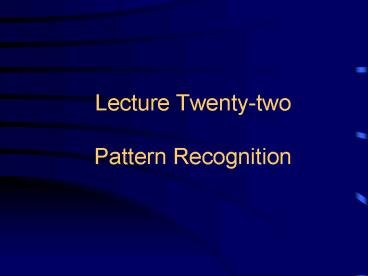Lecture Twentytwo Pattern Recognition - PowerPoint PPT Presentation
1 / 9
Title:
Lecture Twentytwo Pattern Recognition
Description:
The interface between the world and the pattern recognition system is provided by sensors ... features extracted from the input data form a feature space. blue ... – PowerPoint PPT presentation
Number of Views:49
Avg rating:3.0/5.0
Title: Lecture Twentytwo Pattern Recognition
1
Lecture Twenty-twoPattern Recognition
2
Introduction
- The purpose of pattern recognition is to place
objects in a given world into categories - The interface between the world and the pattern
recognition system is provided by sensors
3
Pattern Recognition Procedure
- The first step of the procedure extracts features
from the input data which characterise the
objects. - Based on these features, the objects are
identified and sorted into classes.
4
Labels
- In order to sort the objects, the system needs
information concerning the features of the
objects i.e. the system needs a label
5
Types of Pattern Recognition System
- Un-Supervised
- These are able to generate their labels
themselves, assigning them to objects with
similar features which could belong to the same
class. These systems cannot recognise the object
they are analysing.
6
Types of Pattern Recognition System
- Supervised
- These systems are taught such information as
this is a banana. The work for this system is
divided into two stages - Training step - requires a teacher who describes
the properties of each class. - Classification step - compares the features of an
actual object with those values which have been
taught. The object is assigned to the class
which fits best.
7
Problem with second approach
- If someone inserts a foreign object into a fruit
recognising system (e.g. a calculator), then
there is a class into which the calculator fits
better than any other. This can be overcome by
introducing a rejection level which tests the
limits of similarity.
8
Feature Space
- The features extracted from the input data form a
feature space
colour
blue
Plum
green
Apple
Banana
yellow
Orange
red
compactness
(surface areaVolume)
9
Problems with the Feature Space
- Too few or unsuitable features results in classes
which are not separable - If an appropriate choice of features is not
possible, or too expensive, then the aim should
be to use features leading to a minimum
classification error. - To avoid the classification errors, it may be
necessary to reduce the world, e.g. restrict
the colour of apples to green. If this is not
practical, then an additional feature must be
introduced,e.g. surface texture.































